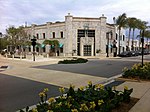Mar-a-Lago

Mar-a-Lago (; Spanish for 'Sea-to-Lake') is a resort and National Historic Landmark in Palm Beach, Florida, owned since 1985 by Donald Trump. Mar-a-Lago was built for businesswoman and socialite Marjorie Merriweather Post between the years 1924 and 1927 during the 1920s Florida land boom. At the time of her death in 1973, Post bequeathed the property to the National Park Service, hoping it could be used for state visits or as a Winter White House, but because the costs of maintaining the property exceeded the funds provided by Post, and because it was difficult to secure the facility, the property was returned to the Post Foundation by an act of Congress in 1981.Trump acquired Mar-a-Lago in 1985 and used the 126-room, 62,500-square-foot (5,810 m2) mansion as a residence before 1994 when he converted it into the Mar-a-Lago Club, a members-only club with guest rooms, a spa and other hotel-style amenities. His family maintains private quarters in a separate, closed-off area of the house and grounds, marked by decorative dolphins. During his tenure as president of the United States, Trump frequently visited Mar-a-Lago and hosted meetings with international leaders there, including Japanese prime minister Shinzo Abe and Chinese president Xi Jinping. Since 2019, Trump has designated the estate as his primary residence.
Excerpt from the Wikipedia article Mar-a-Lago (License: CC BY-SA 3.0, Authors, Images).Mar-a-Lago
South Ocean Boulevard,
Geographical coordinates (GPS) Address Phone number Website External links Nearby Places Show on map
Geographical coordinates (GPS)
| Latitude | Longitude |
|---|---|
| N 26.676944444444 ° | E -80.036944444444 ° |
Address
Mar-a-Lago Club;Mar-A-Lago National Historical Site
South Ocean Boulevard 1100
33480
Florida, United States
Open on Google Maps








